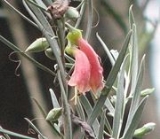
Eremophila youngii
Encyclopedia
Eremophila youngii is a species of shrub that occurs in arid and semi-arid areas of Western Australia
.
, based on specimens collected at Queen Victoria Spring by Jess Young
during the Giles expedition of May 1875. The specific name honours Young.
There are no published subspecies or varieties, but an unpublished subspecies has been provisionally named E. y. subsp. lepidota by Robert Chinnock. This subspecies, which occurs at the northern limits of the species' distribution, has been declared "Priority Four - Poorly Known Taxa" on the Declared Rare and Priority Flora List of Western Australia's Department of Environment and Conservation.
.
Western Australia
Western Australia is a state of Australia, occupying the entire western third of the Australian continent. It is bounded by the Indian Ocean to the north and west, the Great Australian Bight and Indian Ocean to the south, the Northern Territory to the north-east and South Australia to the south-east...
.
Description
It is a shrub or small tree from one to 5.4 metres high. It has purple, red or pink flowers, occurring from January to March and from June to October.Taxonomy
The species was first published in 1876 by Ferdinand von MuellerFerdinand von Mueller
Baron Sir Ferdinand Jacob Heinrich von Mueller, KCMG was a German-Australian physician, geographer, and most notably, a botanist.-Early life:...
, based on specimens collected at Queen Victoria Spring by Jess Young
Jess Young
Jess Young was an explorer who accompanied Ernest Giles during his fourth expedition, making some important botanical collections along the way.Little is known of his early life; it is not even certain whether "Jess" was a full given name or an abbreviation...
during the Giles expedition of May 1875. The specific name honours Young.
There are no published subspecies or varieties, but an unpublished subspecies has been provisionally named E. y. subsp. lepidota by Robert Chinnock. This subspecies, which occurs at the northern limits of the species' distribution, has been declared "Priority Four - Poorly Known Taxa" on the Declared Rare and Priority Flora List of Western Australia's Department of Environment and Conservation.
Distribution
It occurs throughout the western areas of arid and semi-arid Western Australia. It grows on floodplains, clay flats, semi-saline areas and drainage lines, and amongst stony hills. It prefers red sand, clay or loams, calcrete and lateriteLaterite
Laterites are soil types rich in iron and aluminium, formed in hot and wet tropical areas. Nearly all laterites are rusty-red because of iron oxides. They develop by intensive and long-lasting weathering of the underlying parent rock...
.

